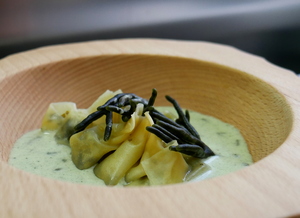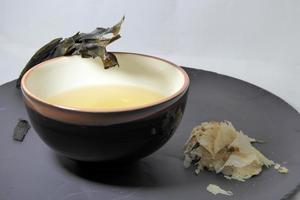Kombu seaweed
Seasonal period:
All year
Allergens
Its scientific name (Saccharina) comes from the sweet taste of the glutamic acid it contains and the fructose and mannitol sugars. It originates from Japan. It grows wild in deep cold waters. It is grown in Spain, France, China, Japan, Russia and Korea.
It is a seaweed from the same family as the kelp. It has a yellow brownish colour and they are the longest seaweeds, reaching up to 450 meters in big depths. They are a bit fleshy and very tasty.
Kombu seaweed is used in the same way as wakame, in soups, stews, broths, in legumes and vegetal proteins such as tofu, tempeh and seitan or fried and toasted as a side dish. It is one of the algae used in miso soup.
Nutritional information (0.1 kg)
Energy
165.0
kcal
Carbohydrates
0.0
g
Proteins
7.1
g
Lipids
1.6
g
Sugars
0.0
g
Salt (Sodium)
1800.0
mg
Folic acid
0.0
ug
Vitamin C
15.0
g
Vitamin A
86.0
ug
Zinc
6.2
mg
Iron
12.6
mg
Calcium
900.0
mg
Cholesterol
0.0
mg
Polyunsaturated fatty acids
0.0
g
Monounsaturated fatty acids
0.0
g
Saturates
0.0
g
Fiber
58.7
g
The data is merely a guide and should not be used for medical purposes. Those responsible for the web disclaims any responsibility.
-
Type of dish
- Beers
- Cocktails
- Breakfasts and brunch
- Burguers
- Juices, milkshakes and beverages
- Shellfish
- Bread and pastries
- Pizzas, patty
- Dessert
- Pasta
- Sándwich
- Pastries
- Finger foods
- Ice creams and sorbets
- Legumes
- Salads
- Eggs
- Patty
- liqueur
- Harvard plate
- Main course
- Meats
- Fish
- Birds
- Vegetables
- Soups and creams
- Rices
- Coffee, chocolate and infusion
- Cheeses
- Appetizers and canapes
- Temperature
- Cuisine type
- Additional culinary preparation
- Conservation technique
- Seasonal recipes
-
- Aromatic herbs
- Beverages
- Big game hunt
- Bread and pastries
- Canned goods and pickles
- Cereals
- Condiments, spices and additives
- Cooked, salted, preserved and cold meats
- Dried fruits and nuts
- Dry pulses
- Edible oils and vinegars
- Eggs and derivatives
- Feathered game hunt
- Fish cuts
- Fishes
- Insects
- Kitchen and bakery tecniques
- Kitchen and bakery utensils
- Meat cuts
- Meats
- Milk, cream and derivatives
- Mushrooms
- Offal
- Pasta, rice, flour and derivatives
- Poultry
- Seafood
- Service techniques
- Service utensils
- Vegetables cuts
- Vegetables, fruits, tubers and seaweed



